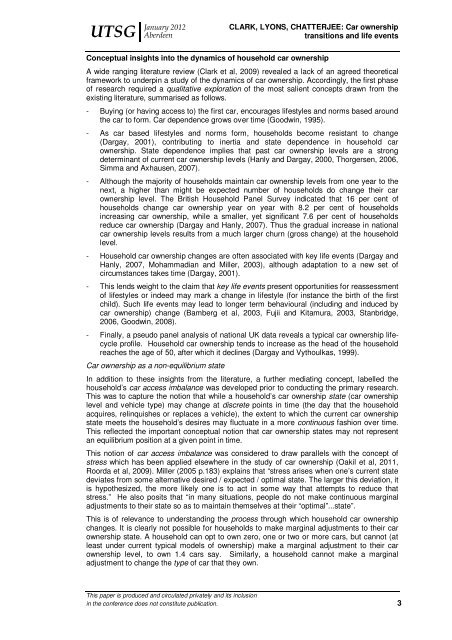Clark, B., Lyons, G. and Chatterjee, K. (2012) - UWE Research ...
Clark, B., Lyons, G. and Chatterjee, K. (2012) - UWE Research ...
Clark, B., Lyons, G. and Chatterjee, K. (2012) - UWE Research ...
You also want an ePaper? Increase the reach of your titles
YUMPU automatically turns print PDFs into web optimized ePapers that Google loves.
UTSG<br />
January <strong>2012</strong><br />
Aberdeen<br />
CLARK, LYONS, CHATTERJEE: Car ownership<br />
transitions <strong>and</strong> life events<br />
Conceptual insights into the dynamics of household car ownership<br />
A wide ranging literature review (<strong>Clark</strong> et al, 2009) revealed a lack of an agreed theoretical<br />
framework to underpin a study of the dynamics of car ownership. Accordingly, the first phase<br />
of research required a qualitative exploration of the most salient concepts drawn from the<br />
existing literature, summarised as follows.<br />
- Buying (or having access to) the first car, encourages lifestyles <strong>and</strong> norms based around<br />
the car to form. Car dependence grows over time (Goodwin, 1995).<br />
- As car based lifestyles <strong>and</strong> norms form, households become resistant to change<br />
(Dargay, 2001), contributing to inertia <strong>and</strong> state dependence in household car<br />
ownership. State dependence implies that past car ownership levels are a strong<br />
determinant of current car ownership levels (Hanly <strong>and</strong> Dargay, 2000, Thorgersen, 2006,<br />
Simma <strong>and</strong> Axhausen, 2007).<br />
- Although the majority of households maintain car ownership levels from one year to the<br />
next, a higher than might be expected number of households do change their car<br />
ownership level. The British Household Panel Survey indicated that 16 per cent of<br />
households change car ownership year on year with 8.2 per cent of households<br />
increasing car ownership, while a smaller, yet significant 7.6 per cent of households<br />
reduce car ownership (Dargay <strong>and</strong> Hanly, 2007). Thus the gradual increase in national<br />
car ownership levels results from a much larger churn (gross change) at the household<br />
level.<br />
- Household car ownership changes are often associated with key life events (Dargay <strong>and</strong><br />
Hanly, 2007, Mohammadian <strong>and</strong> Miller, 2003), although adaptation to a new set of<br />
circumstances takes time (Dargay, 2001).<br />
- This lends weight to the claim that key life events present opportunities for reassessment<br />
of lifestyles or indeed may mark a change in lifestyle (for instance the birth of the first<br />
child). Such life events may lead to longer term behavioural (including <strong>and</strong> induced by<br />
car ownership) change (Bamberg et al, 2003, Fujii <strong>and</strong> Kitamura, 2003, Stanbridge,<br />
2006, Goodwin, 2008).<br />
- Finally, a pseudo panel analysis of national UK data reveals a typical car ownership lifecycle<br />
profile. Household car ownership tends to increase as the head of the household<br />
reaches the age of 50, after which it declines (Dargay <strong>and</strong> Vythoulkas, 1999).<br />
Car ownership as a non-equilibrium state<br />
In addition to these insights from the literature, a further mediating concept, labelled the<br />
household’s car access imbalance was developed prior to conducting the primary research.<br />
This was to capture the notion that while a household’s car ownership state (car ownership<br />
level <strong>and</strong> vehicle type) may change at discrete points in time (the day that the household<br />
acquires, relinquishes or replaces a vehicle), the extent to which the current car ownership<br />
state meets the household’s desires may fluctuate in a more continuous fashion over time.<br />
This reflected the important conceptual notion that car ownership states may not represent<br />
an equilibrium position at a given point in time.<br />
This notion of car access imbalance was considered to draw parallels with the concept of<br />
stress which has been applied elsewhere in the study of car ownership (Oakil et al, 2011,<br />
Roorda et al, 2009). Miller (2005 p.183) explains that “stress arises when one’s current state<br />
deviates from some alternative desired / expected / optimal state. The larger this deviation, it<br />
is hypothesized, the more likely one is to act in some way that attempts to reduce that<br />
stress.” He also posits that “in many situations, people do not make continuous marginal<br />
adjustments to their state so as to maintain themselves at their “optimal”...state”.<br />
This is of relevance to underst<strong>and</strong>ing the process through which household car ownership<br />
changes. It is clearly not possible for households to make marginal adjustments to their car<br />
ownership state. A household can opt to own zero, one or two or more cars, but cannot (at<br />
least under current typical models of ownership) make a marginal adjustment to their car<br />
ownership level, to own 1.4 cars say. Similarly, a household cannot make a marginal<br />
adjustment to change the type of car that they own.<br />
This paper is produced <strong>and</strong> circulated privately <strong>and</strong> its inclusion<br />
in the conference does not constitute publication. 3

















